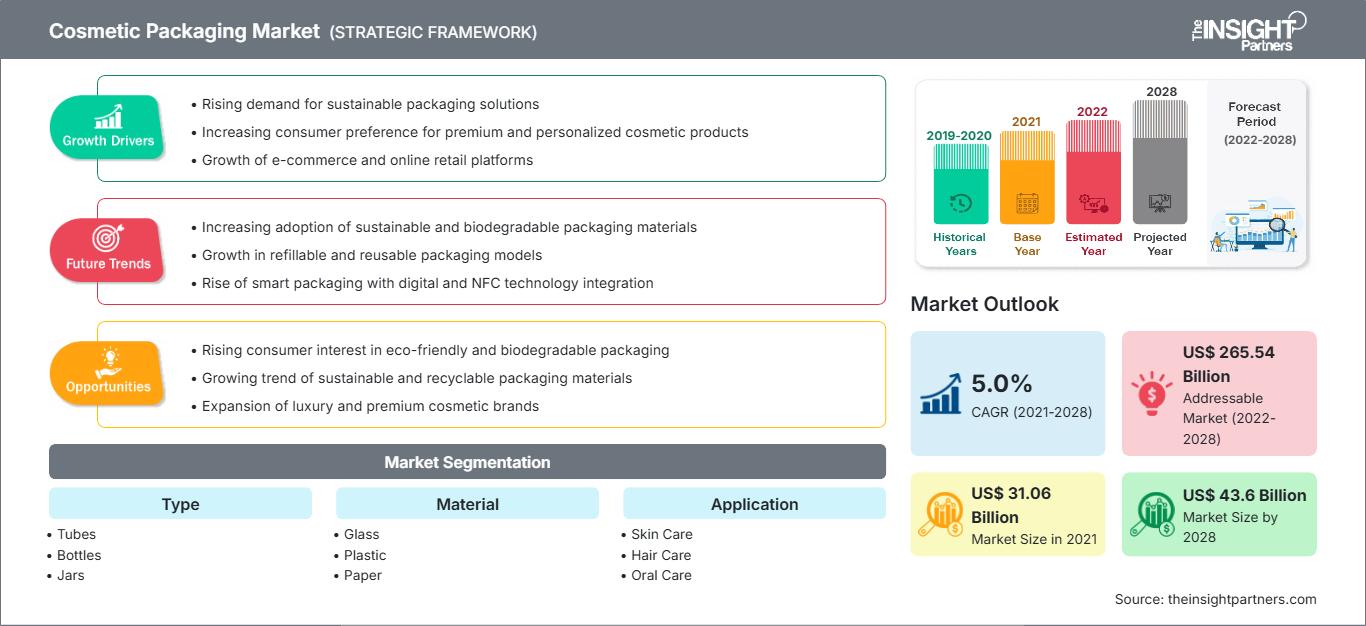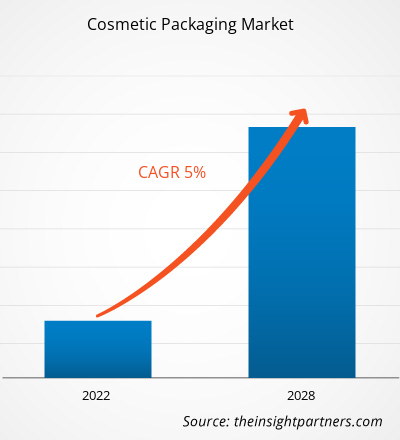Il mercato del packaging cosmetico è stato valutato a 31.064,7 milioni di dollari nel 2021 e si prevede che raggiungerà i 43.597,9 milioni di dollari entro il 2028; si prevede una crescita a un CAGR del 5,0% dal 2021 al 2028.
La crescita del mercato è attribuita alla rapida espansione dell'industria cosmetica, alla crescente tendenza a truccarsi tra le donne e al crescente numero di studi di trucco, cliniche di bellezza e saloni di bellezza in tutto il mondo. Inoltre, i produttori si concentrano sulla creazione di un design di packaging migliore e sulla promozione intelligente del marchio dei loro prodotti attraverso confezioni innovative per attrarre i consumatori. Inoltre, le crescenti vendite di prodotti cosmetici attraverso i canali di vendita al dettaglio online rafforzeranno la crescita del mercato durante il periodo di previsione. Nel 2020, l'area Asia-Pacifico ha detenuto la quota maggiore del mercato globale del packaging cosmetico e si stima che registrerà il CAGR più elevato del mercato durante il periodo di previsione. Il mercato dell'area Asia-Pacifico è suddiviso in Cina, India, Giappone, Corea del Sud e Australia. Paesi come Corea del Sud, Cina e Giappone sono tra i principali mercati per i prodotti cosmetici e per la cura della persona, grazie alla crescente popolarità delle loro esclusive routine di trucco e cura della pelle. Il mercato del packaging cosmetico dell'area Asia-Pacifico sta assistendo a una crescita significativa grazie alla rapida urbanizzazione, al notevole sviluppo economico, alla diversità culturale e alla crescente adozione di nuove tendenze nel settore del trucco.
Potrai personalizzare gratuitamente qualsiasi rapporto, comprese parti di questo rapporto, o analisi a livello di paese, pacchetto dati Excel, oltre a usufruire di grandi offerte e sconti per start-up e università
Mercato degli imballaggi cosmetici: Approfondimenti strategici

- Ottieni le principali tendenze chiave del mercato di questo rapporto.Questo campione GRATUITO includerà l'analisi dei dati, che vanno dalle tendenze di mercato alle stime e alle previsioni.
Approfondimenti di mercato: l'industria cosmetica in crescita
Negli ultimi anni, si è registrata una crescente consapevolezza dell'aspetto fisico tra le persone, con conseguente aumento della domanda di prodotti cosmetici. Nord America ed Europa sono considerati i maggiori mercati cosmetici a livello globale. Secondo i dati di L'Oréal, l'industria cosmetica globale ha registrato un tasso di crescita del 5,5% nel 2019. Secondo Cosmetics Europe, il mercato cosmetico europeo è cresciuto da 89,30 dollari nel 2018 a 90,66 dollari nel 2019. Inoltre, si prevede che un aumento della domanda di cosmetici dovuto alle mutevoli tendenze di cura della persona tra uomini e donne guiderà l'industria cosmetica. Negli ultimi anni, il settore si è spostato da una base di prodotti rivolta al pubblico femminile a un settore che serve tutti i sessi, ampliando la base di consumatori del settore. L'espansione della base di consumatori nel settore cosmetico ha portato a un'elevata domanda di prodotti per il packaging cosmetico, stimolando ulteriormente la crescita del mercato. Approfondimenti sulle applicazioni In base all'applicazione, il mercato globale del packaging cosmetico è segmentato in cura della pelle, cura dei capelli, igiene orale e altri. Nel 2020, il segmento della cura della pelle ha rappresentato la quota di fatturato maggiore. Il crescente numero di influencer di bellezza lancia vari tutorial su trucco e cura della pelle che stanno riscuotendo grande successo tra il pubblico. Inoltre, la crescente tendenza all'uso di prodotti come creme solari, creme da notte riparatrici e profumi, stimola la domanda di prodotti per la cura della pelle. Il packaging cosmetico viene utilizzato per vari prodotti per la cura della pelle, come creme idratanti, creme per le mani, detergenti ed esfolianti. Il packaging dei prodotti per la cura della pelle è progettato per proteggere il prodotto da aria, luce, calore, freddo, umidità, polvere e sporco e proteggerlo da manomissioni. Ad esempio, il packaging in polipropilene viene utilizzato in un'ampia gamma di prodotti per la cura della pelle grazie alla sua flessibilità, che lo rende una scelta migliore per i tubetti comprimibili. Inoltre, i marchi di prodotti per la cura della pelle hanno iniziato a riconoscere i benefici ambientali del packaging per la cura della pelle.
ALBEA; APC PACKAGING; AptarGroup, Inc.; Berry Global Inc.; Gerresheimer AG; WWP Beauty; Silgan Plastics; Huhtamaki; LIBO Cosmetics; e HCP Packaging sono tra i principali attori del mercato del packaging cosmetico. Queste aziende offrono un'ampia gamma di prodotti per il mercato. La loro presenza nelle regioni in via di sviluppo offre opportunità redditizie per la crescita del mercato del packaging cosmetico. Gli operatori del mercato stanno sviluppando prodotti innovativi e di alta qualità per soddisfare le esigenze dei clienti.
In evidenza nel rapporto
- Tendenze progressive del settore nel mercato degli imballaggi cosmetici per aiutare gli operatori a sviluppare strategie efficaci a lungo termine
- Strategie di crescita aziendale adottate dai mercati sviluppati e in via di sviluppo
- Analisi quantitativa del mercato degli imballaggi cosmetici dal 2019 al 2028
- Stima della domanda globale di imballaggi cosmetici
- Analisi delle cinque forze di Porter per illustrare l'efficacia di acquirenti e fornitori che operano nel settore
- Sviluppi recenti per comprendere lo scenario competitivo del mercato
- Tendenze e prospettive di mercato, nonché fattori che guidano e frenano la crescita del mercato degli imballaggi cosmetici
- Assistenza nel processo decisionale evidenziando le strategie di mercato che sostengono l'interesse commerciale, portando alla crescita del mercato
- Le dimensioni del mercato degli imballaggi cosmetici in vari nodi
- Panoramica dettagliata e segmentazione del mercato, così come le dinamiche del settore del packaging cosmetico
- Dimensioni del mercato del packaging cosmetico in varie regioni con promettenti opportunità di crescita
Mercato del packaging cosmetico
Le tendenze regionali e i fattori che influenzano il mercato del packaging cosmetico durante il periodo di previsione sono stati ampiamente spiegati dagli analisti di The Insight Partners. Questa sezione illustra anche i segmenti e la geografia del mercato del packaging cosmetico in Nord America, Europa, Asia-Pacifico, Medio Oriente e Africa, America meridionale e centrale.
Ambito del rapporto sul mercato degli imballaggi cosmetici
| Attributo del rapporto | Dettagli |
|---|---|
| Dimensioni del mercato in 2021 | US$ 31.06 Billion |
| Dimensioni del mercato per 2028 | US$ 43.6 Billion |
| CAGR globale (2021 - 2028) | 5.0% |
| Dati storici | 2019-2020 |
| Periodo di previsione | 2022-2028 |
| Segmenti coperti |
By Tipo
|
| Regioni e paesi coperti | Nord America
|
| Leader di mercato e profili aziendali chiave |
|
Densità degli operatori del mercato del packaging cosmetico: comprendere il suo impatto sulle dinamiche aziendali
Il mercato del packaging cosmetico è in rapida crescita, trainato dalla crescente domanda da parte degli utenti finali, dovuta a fattori quali l'evoluzione delle preferenze dei consumatori, i progressi tecnologici e una maggiore consapevolezza dei benefici del prodotto. Con l'aumento della domanda, le aziende stanno ampliando la propria offerta, innovando per soddisfare le esigenze dei consumatori e sfruttando le tendenze emergenti, alimentando ulteriormente la crescita del mercato.

- Ottieni il Mercato degli imballaggi cosmetici Panoramica dei principali attori chiave
L'"Analisi del mercato globale del packaging cosmetico fino al 2028" è uno studio specializzato e approfondito del settore chimico e dei materiali, con particolare attenzione all'analisi delle tendenze del mercato globale del packaging cosmetico. Il rapporto mira a fornire una panoramica del mercato con una segmentazione dettagliata. Il mercato del packaging cosmetico è segmentato in base a tipologia di prodotto, materiale, applicazione e area geografica. Per tipologia, il mercato del packaging cosmetico è suddiviso in tubetti, flaconi, barattoli, pompe e dispenser, tra gli altri. Per materiale, il mercato è suddiviso in vetro, plastica, carta, metallo e altri. Per applicazione, il mercato del packaging cosmetico è suddiviso in prodotti per la cura della pelle, dei capelli, dell'igiene orale e altri. Per area geografica, il mercato è ampiamente segmentato in Nord America, Europa, Asia-Pacifico (APAC), Medio Oriente e Asia-Pacifico (APAC). Africa (MEA) e America meridionale e centrale.
Profili aziendali
- ALBEA
- APC PACKAGING
- AptarGroup, Inc.
- Berry Global Inc.
- Gerresheimer AG
- WWP Beauty
- Silgan Plastics.
- Huhtamaki
- LIBO Cosmetics
- HCP Packaging
- Analisi storica (2 anni), anno base, previsione (7 anni) con CAGR
- Analisi PEST e SWOT
- Valore/volume delle dimensioni del mercato - Globale, Regionale, Nazionale
- Industria e panorama competitivo
- Set di dati Excel
Report recenti
Rapporti correlati
Testimonianze
Motivo dell'acquisto
- Processo decisionale informato
- Comprensione delle dinamiche di mercato
- Analisi competitiva
- Analisi dei clienti
- Previsioni di mercato
- Mitigazione del rischio
- Pianificazione strategica
- Giustificazione degli investimenti
- Identificazione dei mercati emergenti
- Miglioramento delle strategie di marketing
- Aumento dell'efficienza operativa
- Allineamento alle tendenze normative




















 Ottieni un campione gratuito per - Mercato degli imballaggi cosmetici
Ottieni un campione gratuito per - Mercato degli imballaggi cosmetici